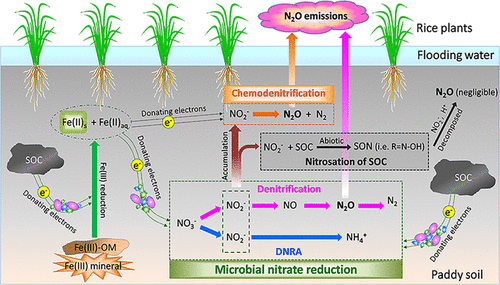当前位置:
X-MOL 学术
›
ACS Earth Space Chem.
›
论文详情
Our official English website, www.x-mol.net, welcomes your
feedback! (Note: you will need to create a separate account there.)
Role of Chemodenitrification for N2O Emissions from Nitrate Reduction in Rice Paddy Soils
ACS Earth and Space Chemistry ( IF 2.9 ) Pub Date : 2019-12-11 , DOI: 10.1021/acsearthspacechem.9b00296 Milan Wang 1, 2 , Ronggui Hu 1 , Reiner Ruser 3 , Caroline Schmidt 2 , Andreas Kappler 2
ACS Earth and Space Chemistry ( IF 2.9 ) Pub Date : 2019-12-11 , DOI: 10.1021/acsearthspacechem.9b00296 Milan Wang 1, 2 , Ronggui Hu 1 , Reiner Ruser 3 , Caroline Schmidt 2 , Andreas Kappler 2
Affiliation

|
Atmospheric nitrous oxide (N2O) causes global warming and ozone depletion. Nitrate and nitrite reduction are the main sources for N2O emission in anoxic environments including both microbial (denitrification) and abiotic reactions (chemodenitrification), besides nitrification in oxic habitats. In flooded paddy soils, substantial concentrations of Fe(II) and nitrite are available, potentially triggering chemodenitrification. It is currently unknown to what extent chemodenitrification contributes to N2O emissions in such environments. We conducted anoxic microcosm experiments with two paddy soils that differ in natural Fe(II) and organic carbon content. We amended them with nitrite or nitrate and quantified N2O emissions. In sterilized soils, nitrite and not nitrate was abiotically reduced, pointing toward chemodenitrification. In microbially active soils, nitrate reduction was accompanied by nitrite accumulation, ammonium production, and N2O emission, implying the co-occurrence of denitrification, dissimilatory nitrate reduction to ammonium (DNRA), and chemodenitrification. N2O emissions from chemodenitrification accounted for 6.8–67.6% of the total N2O emissions, depending on the concentrations of Fe(II), nitrite, nitrate, and organic carbon, and the N2O emission rate from abiotic reactions was up to 2.4 mg N kg–1 d–1. Elevated Fe(II) levels in soils facilitated nitrite accumulation, chemodenitrification, and high abiotic N2O emission (up to 42.9%). In low organic carbon soil, more N2O was emitted by chemodenitrification in nitrite-amended setups (20.5% of total N2O emission) compared to nitrate-amended setups (6.8%). High organic carbon content in soils indirectly enhanced the proportion of abiotic N2O production (up to 67.6%), potentially favoring DNRA over denitrification, which decreased the biotic contribution to N2O formation. Our results suggest that chemodenitrification could be a significant contributor for N2O emissions in paddy soils via a complex network of biotic and abiotic processes involving C, Fe, and N biogeochemical cycling.
中文翻译:

对于N Chemodenitrification的角色2从硝酸盐还原水稻水稻土O排放
大气中的一氧化二氮(N 2 O)导致全球变暖和臭氧消耗。硝酸盐和亚硝酸盐的还原是缺氧环境中N 2 O排放的主要来源,包括微生物(脱氮)和非生物反应(化学脱氮),除了在有氧生境中进行硝化。在淹没的稻田土壤中,可利用大量的Fe(II)和亚硝酸盐,可能会引发化学硝化作用。目前尚不清楚化学硝化在这种环境下对N 2 O排放有多大程度的贡献。我们对两种稻田中天然铁(II)和有机碳含量不同的缺氧微生物进行了实验。我们用亚硝酸盐或硝酸盐修正了它们,并量化了N 2O排放。在无菌土壤中,亚硝酸盐而非硝酸盐被非生物还原,这表明化学硝化作用。在具有微生物活性的土壤中,硝酸盐的还原伴随着亚硝酸盐的积累,铵的产生和N 2 O的排放,这意味着同时发生反硝化,硝酸盐异化还原为铵(DNRA)和化学反硝化。ñ 2个从chemodenitrification O排放占总数为N的6.8-67.6%2 O排放,这取决于Fe的浓度(II),亚硝酸盐,硝酸盐,和有机碳,和N 2从非生物反应O排放率达到至2.4 mg N kg –1 d –1。土壤中Fe(II)含量的升高促进了亚硝酸盐的积累,化学反硝化作用以及非生物N 2 O的高排放(高达42.9%)。在低有机碳土壤中,与亚硝酸盐改良装置(6.8%)相比,在亚硝酸盐改良装置中化学模式硝化会排放更多的N 2 O(占总N 2 O排放量的20.5 %)。土壤中高的有机碳含量间接提高了非生物N 2 O的产生比例(高达67.6%),相比于反硝化作用,DNRA可能更有利于DNRA,从而降低了生物对N 2 O形成的贡献。我们的研究结果表明化学脱氮可能是N 2的重要贡献者。通过涉及C,Fe和N生物地球化学循环的生物和非生物过程的复杂网络,稻田土壤中的O排放。
更新日期:2019-12-13
中文翻译:

对于N Chemodenitrification的角色2从硝酸盐还原水稻水稻土O排放
大气中的一氧化二氮(N 2 O)导致全球变暖和臭氧消耗。硝酸盐和亚硝酸盐的还原是缺氧环境中N 2 O排放的主要来源,包括微生物(脱氮)和非生物反应(化学脱氮),除了在有氧生境中进行硝化。在淹没的稻田土壤中,可利用大量的Fe(II)和亚硝酸盐,可能会引发化学硝化作用。目前尚不清楚化学硝化在这种环境下对N 2 O排放有多大程度的贡献。我们对两种稻田中天然铁(II)和有机碳含量不同的缺氧微生物进行了实验。我们用亚硝酸盐或硝酸盐修正了它们,并量化了N 2O排放。在无菌土壤中,亚硝酸盐而非硝酸盐被非生物还原,这表明化学硝化作用。在具有微生物活性的土壤中,硝酸盐的还原伴随着亚硝酸盐的积累,铵的产生和N 2 O的排放,这意味着同时发生反硝化,硝酸盐异化还原为铵(DNRA)和化学反硝化。ñ 2个从chemodenitrification O排放占总数为N的6.8-67.6%2 O排放,这取决于Fe的浓度(II),亚硝酸盐,硝酸盐,和有机碳,和N 2从非生物反应O排放率达到至2.4 mg N kg –1 d –1。土壤中Fe(II)含量的升高促进了亚硝酸盐的积累,化学反硝化作用以及非生物N 2 O的高排放(高达42.9%)。在低有机碳土壤中,与亚硝酸盐改良装置(6.8%)相比,在亚硝酸盐改良装置中化学模式硝化会排放更多的N 2 O(占总N 2 O排放量的20.5 %)。土壤中高的有机碳含量间接提高了非生物N 2 O的产生比例(高达67.6%),相比于反硝化作用,DNRA可能更有利于DNRA,从而降低了生物对N 2 O形成的贡献。我们的研究结果表明化学脱氮可能是N 2的重要贡献者。通过涉及C,Fe和N生物地球化学循环的生物和非生物过程的复杂网络,稻田土壤中的O排放。











































 京公网安备 11010802027423号
京公网安备 11010802027423号